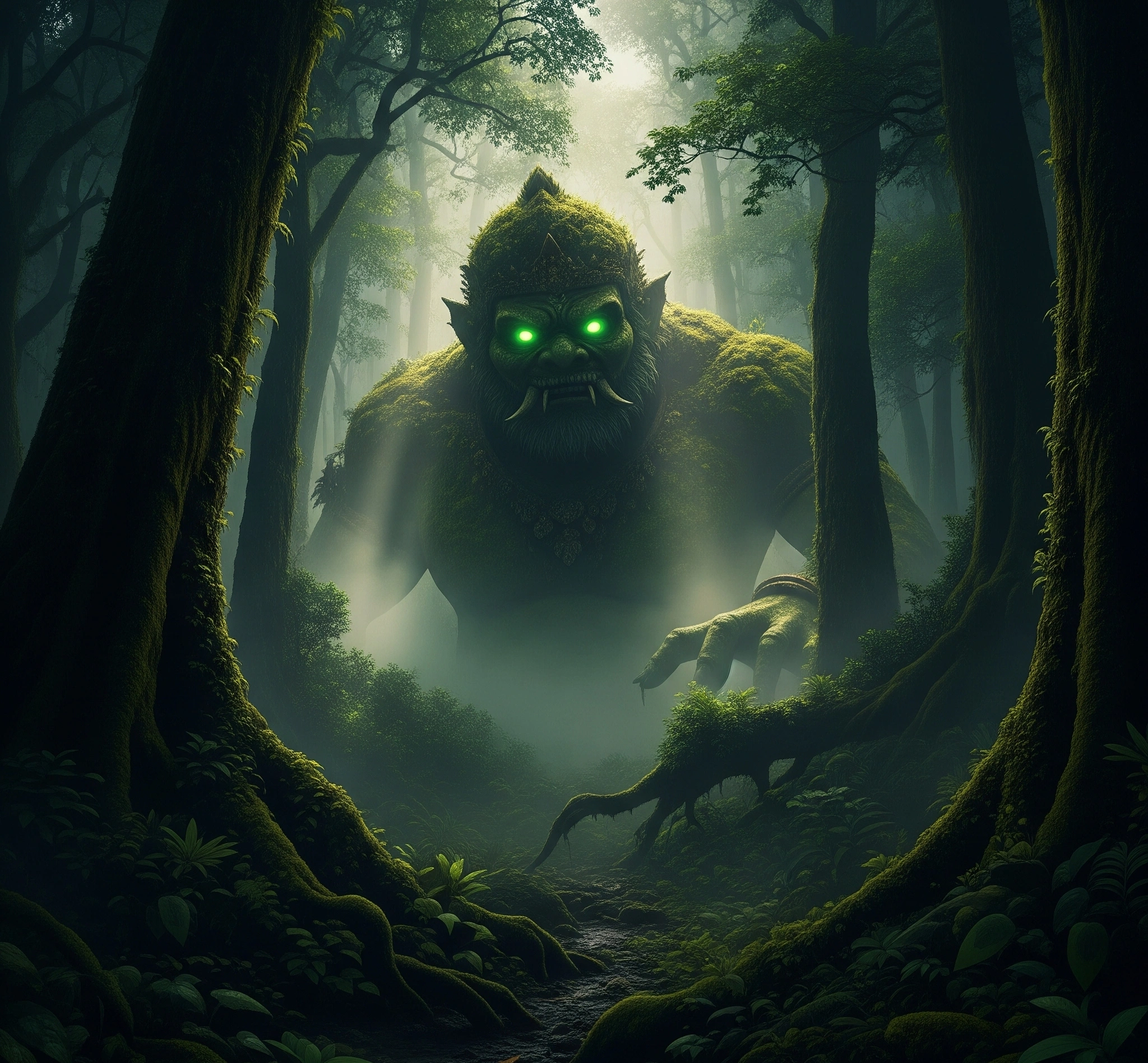Have you ever felt an inexplicable shiver when walking alone at night? Perhaps you’ve experienced the primal unease that arises from stories of lurking dangers. Our collective imagination often conjures figures that embody our deepest anxieties. This article delves into such a figure: Buto Ijo, the legendary Javanese giant. We will explore the “Buto Ijo Legend,” not as a mere scary tale, but as a profound psychological tool. It helps us understand the origins of fear in folklore. This isn’t about superstition. Rather, it’s about practical wisdom. We will uncover how ancient narratives symbolically interpret human experience. They offer insights into managing our modern anxieties.
Table of Contents
- The Forest’s Whisper: Unveiling the Buto Ijo Legend
- Archetypes of Fear and Resilience
- Facing the Inner Giant: Buto Ijo in Modern Life
- Actionable Insights: Confronting Fear with Ancient Wisdom
- Timeless Lessons: Buto Ijo in the Digital Age
- The Echo of the Giant
- Call to Action
- Context and References
The Forest’s Whisper: Unveiling the Buto Ijo Legend
The “Buto Ijo Legend” is a prominent Javanese mythical creature. This terrifying giant is often depicted with green skin, sharp fangs, and bulging eyes. This figure is deeply ingrained in Indonesian folklore. It primarily serves as the antagonist in the popular “Timun Mas” (Golden Cucumber) tale. The legend of Buto Ijo is more than just a scary story. Instead, it offers profound insights into the origins of fear in human experience. It also symbolizes the raw, untamed forces of nature and the consequences of unchecked desires.
The origins of Buto Ijo are rooted in the animistic beliefs of ancient Java. These beliefs predated the arrival of Hinduism, Buddhism, and Islam. Early Javanese societies revered and feared the spirits of nature. They saw powerful entities residing in forests, mountains, and rivers. Buto Ijo embodies these primal fears. His name, “Buto Ijo,” literally translates to “Green Giant.” This further connects him to the lush, yet sometimes dangerous, natural environment of Java. Over centuries, the legend evolved. It became a cautionary tale. It taught children about obedience and the dangers of making pacts with malevolent forces. This is knowledge, not magic. Rather, it is a guide, not a prophecy. Ultimately, it is a symbolic interpretation of human experience. It offers timeless wisdom for navigating life’s tests.
Archetypes of Fear and Resilience
The “Buto Ijo Legend” is rich with archetypal characters. Each represents a fundamental aspect of human psychology and societal dynamics. Understanding these patterns provides a powerful lens. Through this lens, we can examine our own fears and strengths.
Buto Ijo: The Embodiment of Primal Fear
Buto Ijo, the Javanese giant, is the central figure of dread. He symbolizes uncontrolled power, primal fear, and the destructive consequences of greed. His monstrous appearance and insatiable hunger represent the untamed aspects of nature. He also embodies the darker impulses within humanity. Indeed, he demands a human sacrifice in exchange for a child. This highlights the terrifying cost of desperate desires. In life, our “Buto Ijo” might be overwhelming anxiety, destructive habits, or external pressures that threaten to consume us. He challenges us to confront our deepest fears. Furthermore, he reminds us of the importance of self-control and ethical boundaries.
Timun Mas: The Spirit of Courage and Resourcefulness
Timun Mas, the protagonist of the tale, embodies courage, intelligence, and unwavering resilience. She is born from a golden cucumber. She faces the terrifying threat of Buto Ijo. Despite her small stature, she outwits the giant using magical seeds. These seeds transform into obstacles. Her journey highlights the triumph of wit over brute force. It also shows the power of inner strength against overwhelming odds. Ultimately, Timun Mas teaches us that even in the face of immense fear, we possess the inner resources to overcome challenges. She inspires us to be resourceful and brave, even when circumstances seem dire.
The Farmer Couple: The Fragility of Human Desire
The childless farmer couple represents human longing, desperation, and the potential pitfalls of unchecked desire. Their fervent wish for a child leads them to make a dangerous pact with Buto Ijo. This decision ultimately puts Timun Mas in peril. Their actions serve as a cautionary tale. It highlights how desperate desires can blind us to long-term consequences. Moreover, they show the importance of considering the ethical implications of our choices. Their struggle reflects the universal human experience of wanting something so badly that we might overlook the risks involved. Their dualities lie in their loving intent and their perilous agreement.
Facing the Inner Giant: Buto Ijo in Modern Life
Consider Leo, a young entrepreneur. He launched a promising tech startup. Leo, much like the farmer couple, harbored a strong desire for success and recognition. His “Buto Ijo” manifested as the relentless pressure of the startup world. This included investor expectations, tight deadlines, and the fear of failure. He felt an insatiable hunger to grow his company rapidly. This sometimes pushed him to the brink of ethical compromise.
Leo often found himself tempted by “shortcuts.” These were like Buto Ijo’s demands. For example, he considered cutting corners on data privacy or over-promising features to secure funding. He saw other startups engaging in aggressive, sometimes unethical, tactics. This made him question his own integrity. This was his “Buto Ijo” whispering promises of rapid expansion if he just “paid the price” of his ethical code. The constant pressure led to immense stress and anxiety. Consequently, he felt like he was constantly running from a giant, much like Timun Mas.
One critical moment arrived. A major investor offered significant funding. However, it came with a condition: Leo had to implement a questionable data collection practice. This practice would violate user trust. Leo felt immense pressure. Yet, he remembered his core values. He realized that compromising his ethics would create a monstrous “Buto Ijo” within his company. Therefore, he chose to decline the offer. Instead, he sought alternative, more ethical funding. This was his “Timun Mas” moment. He used his resourcefulness and courage. He threw “seeds” of integrity and long-term vision. These helped him escape the immediate threat. Leo’s story illustrates how ancient wisdom helps us navigate moral dilemmas and overcome fear in the complex modern business landscape.
Actionable Insights: Confronting Fear with Ancient Wisdom
Understanding the archetypes of the “Buto Ijo Legend” is more than just cultural appreciation. Indeed, it’s an invitation to profound self-reflection and practical application. True transformation requires concrete action. This means integrating these timeless lessons into our daily lives. These are empowering self-practices, not mystical rituals to control external forces.
Identifying Your “Buto Ijo”: Understanding Personal Fears
Just as Buto Ijo embodies external threats, our inner “giants” represent our deepest fears and anxieties.
- Fear Mapping: Journal about your greatest fears. What are they? Where do they come from? How do they manifest in your daily life? Giving them a name helps to demystify them.
- Acknowledge the “Hunger”: Recognize the insatiable aspects of your fears. Do they demand too much of your energy, time, or peace of mind? Understanding their “hunger” is the first step to managing it.
- Confrontation in Small Steps: Instead of letting fear paralyze you, take small, deliberate steps to confront it. This could be practicing public speaking if you fear it, or setting boundaries if you fear confrontation.
Cultivating Timun Mas-like Resilience: Practical Strategies
Timun Mas used her wit and courage to overcome Buto Ijo. We can cultivate similar resilience.
- Develop Resourcefulness: When faced with a challenge, brainstorm multiple solutions. Don’t just stick to the obvious. Think creatively, like Timun Mas with her seeds.
- Strengthen Your Inner Core: Practice mindfulness or meditation. This helps build mental fortitude. It allows you to remain calm under pressure.
- Seek Mentors/Support: Timun Mas received help from a hermit. Similarly, identify people in your life who can offer guidance, support, or different perspectives when you face overwhelming challenges.
Navigating Desire and Consequence: Mindful Choices
The farmer couple’s story reminds us to be mindful of our desires and their potential costs.
- The “Pact” Analysis: Before making a significant decision driven by strong desire, ask yourself: What are the potential hidden costs? Am I compromising my values for short-term gain?
- Long-Term Vision: Consider the long-term implications of your choices. Will this decision lead to future regrets or ethical dilemmas? Prioritize sustainable well-being over immediate gratification.
- Gratitude Practice: Cultivate gratitude for what you have. This reduces the intensity of desires that might lead to dangerous “pacts.”
Timeless Lessons: Buto Ijo in the Digital Age

The enduring relevance of the “Buto Ijo Legend” resonates deeply in our contemporary world. In an era of information overload, social media pressures, and global uncertainties, the story serves as a vital framework. It addresses pervasive challenges like anxiety, decision paralysis, and the pursuit of success at any cost. These are often fueled by external pressures and the fear of missing out.
This ancient wisdom provides tangible benefits to the reader’s daily life. It offers a framework for:
- Managing Anxiety: It helps us externalize and understand our fears. This allows us to develop strategies for confronting them, rather than being overwhelmed.
- Ethical Decision-Making: It provides a moral compass. This guides us through complex choices. It highlights the importance of integrity over expediency.
- Building Resilience: It inspires us to cultivate inner strength and resourcefulness. These are crucial for navigating life’s inevitable challenges and setbacks.
- Mindful Consumption: It encourages critical thinking about desires. It helps us avoid making “pacts” with tempting, yet ultimately harmful, influences in our personal and professional lives.
The Echo of the Giant
The “Buto Ijo Legend” is far more than a simple cautionary tale. Indeed, it serves as a profound mirror, reflecting the eternal human struggle against fear, temptation, and the consequences of our desires. This narrative demystifies the idea of monsters; they are not merely external entities. Instead, these figures are symbolic representations of our inner challenges. Ultimately, the story empowers us. It helps us recognize the “giants” in our own lives. Furthermore, it encourages us to cultivate the courage and wisdom of Timun Mas. Its enduring message is one of empowerment: true strength lies not in avoiding fear, but in confronting it with integrity and resourcefulness. This inner power ultimately leads to genuine freedom and peace.
“Even the tallest shadow is cast by a light within.”
Call to Action
Ready to confront your own “giants” and cultivate unwavering resilience?
DISCOVER YOUR INNER RESILIENCE AND OVERCOME CHALLENGES HERE
Context and References
Internal Links to Related Articles:
- Read more about the universal principles of [Javanese Mythology and its Meanings].
- Discover how [The Philosophy of Courage in Folklore] influences personal growth.
- Explore [The Symbolism of Monsters in World Mythology].
- Understand [Mindful Decision-Making in a Complex World].
External References:
- Wikipedia: Buto Ijo (for general overview and cultural context)
- Academic papers on Javanese folklore and the psychology of fear (if specific scholarly sources were consulted for deeper analysis).
Disclaimer: This content is provided for educational and cultural understanding. Javanese mythical concepts and folklore are part of a rich tradition, offering guidance for self-reflection and personal growth, not deterministic prophecies or absolute judgments.
